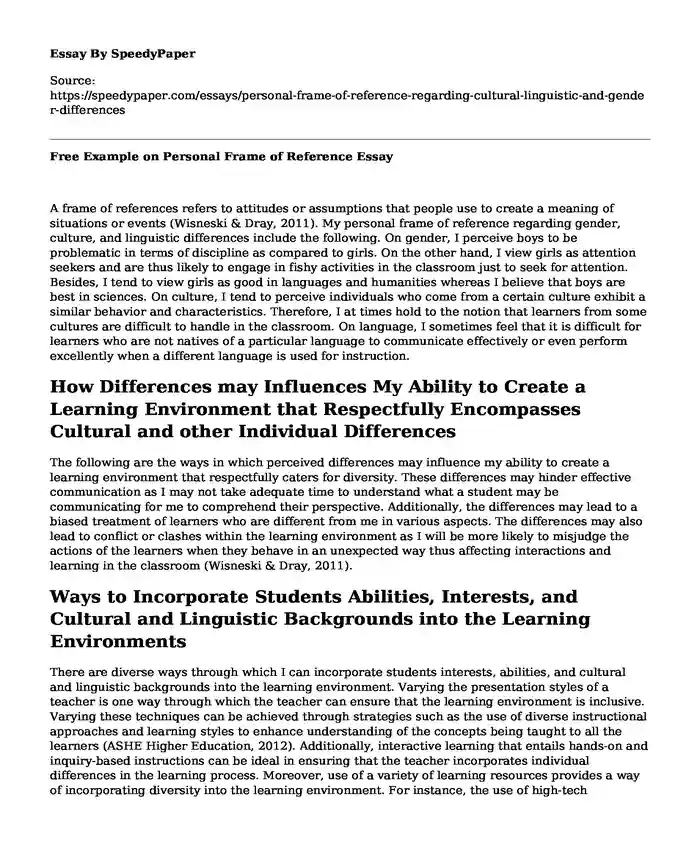A frame of references refers to attitudes or assumptions that people use to create a meaning of situations or events (Wisneski & Dray, 2011). My personal frame of reference regarding gender, culture, and linguistic differences include the following. On gender, I perceive boys to be problematic in terms of discipline as compared to girls. On the other hand, I view girls as attention seekers and are thus likely to engage in fishy activities in the classroom just to seek for attention. Besides, I tend to view girls as good in languages and humanities whereas I believe that boys are best in sciences. On culture, I tend to perceive individuals who come from a certain culture exhibit a similar behavior and characteristics. Therefore, I at times hold to the notion that learners from some cultures are difficult to handle in the classroom. On language, I sometimes feel that it is difficult for learners who are not natives of a particular language to communicate effectively or even perform excellently when a different language is used for instruction.
How Differences may Influences My Ability to Create a Learning Environment that Respectfully Encompasses Cultural and other Individual Differences
The following are the ways in which perceived differences may influence my ability to create a learning environment that respectfully caters for diversity. These differences may hinder effective communication as I may not take adequate time to understand what a student may be communicating for me to comprehend their perspective. Additionally, the differences may lead to a biased treatment of learners who are different from me in various aspects. The differences may also lead to conflict or clashes within the learning environment as I will be more likely to misjudge the actions of the learners when they behave in an unexpected way thus affecting interactions and learning in the classroom (Wisneski & Dray, 2011).
Ways to Incorporate Students Abilities, Interests, and Cultural and Linguistic Backgrounds into the Learning Environments
There are diverse ways through which I can incorporate students interests, abilities, and cultural and linguistic backgrounds into the learning environment. Varying the presentation styles of a teacher is one way through which the teacher can ensure that the learning environment is inclusive. Varying these techniques can be achieved through strategies such as the use of diverse instructional approaches and learning styles to enhance understanding of the concepts being taught to all the learners (ASHE Higher Education, 2012). Additionally, interactive learning that entails hands-on and inquiry-based instructions can be ideal in ensuring that the teacher incorporates individual differences in the learning process. Moreover, use of a variety of learning resources provides a way of incorporating diversity into the learning environment. For instance, the use of high-tech resources, interacting with people of different cultures, and traveling to different areas can enrich a learning environment characterized by diversity (Barst, 2013). Furthermore, a teacher can demonstrate high expectations for all students in a classroom. This demonstration will make all the learners to learn more effectively as they will feel challenged and know that the teacher has the belief in them to succeed even in challenging activities (Cole, 2008).
What Is a Cultural Frame of Reference?
This term is a form of cultural characteristics of an individual or a nation. The cultural frame is determined by the environment, family values, educational institutions, friends, and other factors. A person is very dependent on society and the environment. The formation of views, preferences, and judgments about people and values is formed in a stereotyped manner (due to the imposition of opinions by society and several factors).
That is why cultural boundaries can only be broken if you want to listen to the opposite perspective, compare several behavioral patterns, and accept the concept of not having completely correct decisions. People perceive others exclusively from the standpoint of personal experience imposed by society. That’s why the cultural frame can only be destroyed by openness and the desire to understand other people's positions.
Linguistic Frame of Reference.
This term is very similar to the cultural frame of reference. The only difference is the linguistic aspect. This system allows you to identify the location of the object and even form distinct linguistic expressions. There are Intrinsic, Absolute, and Relative types of frames, which differ in several ways. The first option uses the positioning of one object about a part of another (side, front, etc.).
The absolute frame of reference is distinguished by the use of cardinal directions for object identification. The relative model uses three factors to identify anything: the object itself, its location relative to the second one, and the person watching it.
References
ASHE Higher Education (2012). Practicing a pedagogy that engages diversity. ASHE Higher Education Report, 38(2), 83-101. Retrieved from http://eds.b.ebscohost.com/ehost/pdfviewer/pdfviewer?sid=0c56c4ed-f7e5-469b-8cda-b836c25a83c5%40sessionmgr105&vid=5&hid=122Barst, J. M. (2013).
Pedagogical approaches to diversity in the English classroom: A case study of global feminist literature. Pedagogy, 13(1), 149-157. Retrieved from http://eds.b.ebscohost.com/ehost/pdfviewer/pdfviewer?vid=3&sid=0c56c4ed-f7e5-469b-8cda-b836c25a83c5%40sessionmgr105&hid=122Cole, R. (2008).
Educating Everybody's Children: Diverse Teaching Strategies for Diverse Learners. Alexandria, VA: Association for Supervision and Curriculum Development.
Dray, J. B. and Wisneski, D. B. (2011). Mindful reflection as a process for developing culturally responsive practices. Teaching Exceptional Children, 44(1), 28-36.
Cite this page
Free Example on Personal Frame of Reference. (2019, Oct 31). Retrieved from https://speedypaper.com/essays/personal-frame-of-reference-regarding-cultural-linguistic-and-gender-differences
Request Removal
If you are the original author of this essay and no longer wish to have it published on the SpeedyPaper website, please click below to request its removal:
- Free Essay: Fighting in the Great War and Ending the War
- Free Essay on the Theme of Effective Social Work
- Free Essay on Cinematic Invisibility in the Film, "Brokeback Mountain"
- Free Paper Sample on Gender Roles and Stereotypes
- Fashion, Media, and Self-Esteem. Paper Example
- Paper Example. Biological Domain
- Grant Writing Sources - Essay Sample
Popular categories





